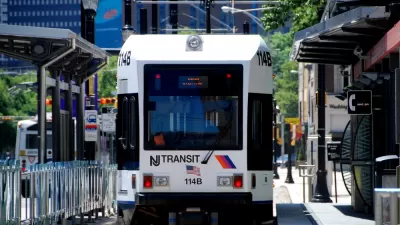Disaster struck New Jersey Transit commuters at 8:38 AM on Sept. 29 when train #1614 failed to stop at the end ot the track and slammed into the wall, then the ceiling of the historic station, killing at least one person and injuring up to 100.
"The cause of the crash at [Hoboken Terminal] was not immediately known," reports Berkeley Lovelace Jr. for CNBC. "NBC New York said authorities believe the crash may have resulted from operator error but stressed that the investigation was preliminary."
The New Jersey Transit was not equipped with the positive train control technology that slows down trains when they exceed the speed limit, NBC News reported. Initial reports indicated that the train did not slow down as it entered the station.
The National Transportation Safety Board said Thursday officials will be looking into the positive train control technology and also for similarities between Thursday morning's crash and one in 2011 at the same station, Reuters reported. [NTSB briefing via YouTube].
However, the 2011 crash involved a Port Authority Trans-Hudson (PATH) subway train, not a commuter train, reports J.D. Durkin for Mediaite.com.
The historic station is the second busiest transportation facility in the Garden State after Newark Airport. Passengers arriving on the New Jersey Transit Pascack Valley Line train from Spring Valley, along with passengers from seven other NJ Transit commuter lines [see map] and one Metro-North line, could transfer to:
- NY Waterway Hudson River Ferries to New York
- Hudson-Bergen Light Rail
- Two Port Authority Trans-Hudson (PATH) heavy rail lines to New York
- NJ Transit buses
"The landmark Hoboken Terminal, one of the metropolitan's major transportation hubs, underwent a $115 million renovation project 10 years ago," reports Ron Zeitlinger of The Jersey Journal.
The building, built in 1907 and owned by New Jersey Transit, underwent more renovations after it was flooded in superstorm Sandy in 2012.
This morning's crash caused major damage to the interior of the terminal and there was a partial roof collapse as well.
According to a NJ Transit commuter alert, "All [commuter] rail service into and out of Hoboken Terminal remains suspended. All Hudson Bergen Light Rail service into and out of Hoboken station remains suspended."
A PATH press release indicates that service will resume at 3 PM on Thursday, Sept. 29.
NJ Transit operates the second busiest commuter rail system in the U.S. after the Long Island Rail Road. Direct rail service to New York Penn Station is available from Secaucus Junction. See map below.
Related Planetizen coverage:
- Railroads Given Three More Years to Install Positive Train Control, October 24, 2015
- Positive Train Control Set to Revolutionize Railroad Safety, February 14, 2012

FULL STORY: Hoboken train crash kills 1, injures 108, Gov. Chris Christie says

Study: Maui’s Plan to Convert Vacation Rentals to Long-Term Housing Could Cause Nearly $1 Billion Economic Loss
The plan would reduce visitor accommodation by 25,% resulting in 1,900 jobs lost.

Alabama: Trump Terminates Settlements for Black Communities Harmed By Raw Sewage
Trump deemed the landmark civil rights agreement “illegal DEI and environmental justice policy.”

Why Should We Subsidize Public Transportation?
Many public transit agencies face financial stress due to rising costs, declining fare revenue, and declining subsidies. Transit advocates must provide a strong business case for increasing public transit funding.

Paris Bike Boom Leads to Steep Drop in Air Pollution
The French city’s air quality has improved dramatically in the past 20 years, coinciding with a growth in cycling.

Why Housing Costs More to Build in California Than in Texas
Hard costs like labor and materials combined with ‘soft’ costs such as permitting make building in the San Francisco Bay Area almost three times as costly as in Texas cities.

San Diego County Sees a Rise in Urban Coyotes
San Diego County experiences a rise in urban coyotes, as sightings become prevalent throughout its urban neighbourhoods and surrounding areas.
Urban Design for Planners 1: Software Tools
This six-course series explores essential urban design concepts using open source software and equips planners with the tools they need to participate fully in the urban design process.
Planning for Universal Design
Learn the tools for implementing Universal Design in planning regulations.
Smith Gee Studio
Alamo Area Metropolitan Planning Organization
City of Santa Clarita
Institute for Housing and Urban Development Studies (IHS)
City of Grandview
Harvard GSD Executive Education
Toledo-Lucas County Plan Commissions
Salt Lake City
NYU Wagner Graduate School of Public Service



























